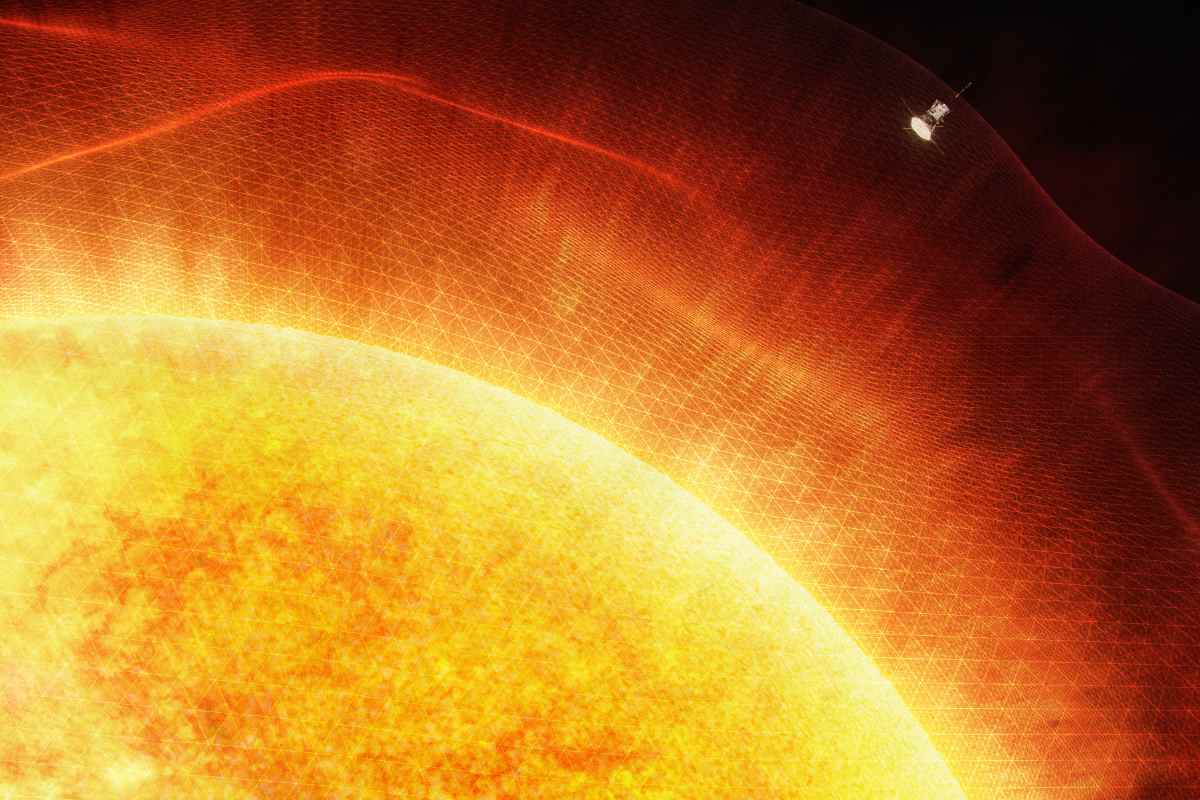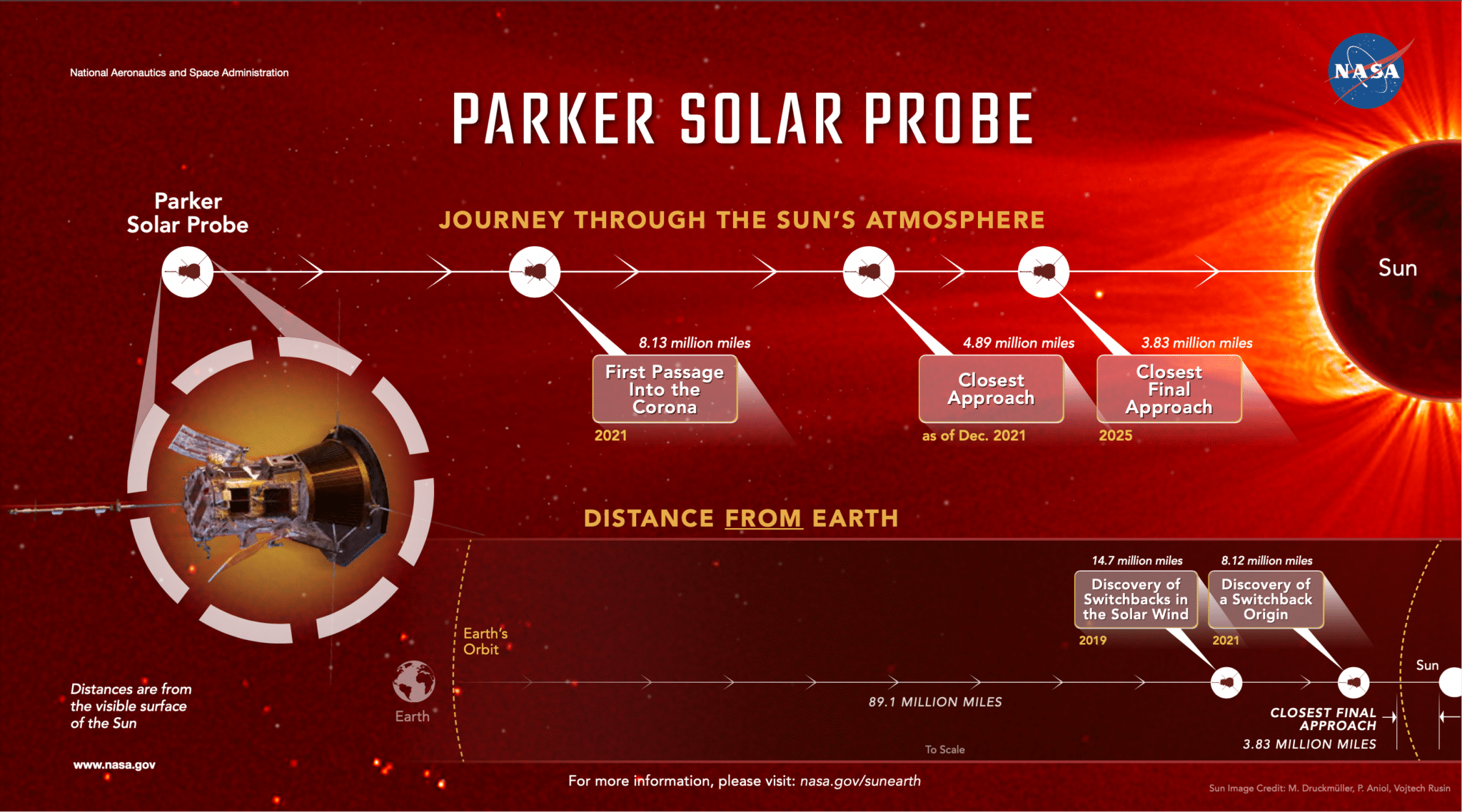
NASA’s Parker Solar Probe has flown through the sun’s upper atmosphere — the corona. And this is what he discovered.
For the first time in history, a spacecraft has ‘touched’ the sun. NASA has announced that. The new milestone marks an immense leap forward for solar science. Because just as the moon landing enabled scientists to understand how our natural satellite came to be, touching the sun’s material will help researchers uncover crucial information about our nearest star and its influence on the solar system.
Parker Solar Probe is an exciting mission that takes a closer look at our sun. Our sun contains 99.86% of all the mass in our solar system and yet we have never been so close to this gigantic mass. It means that we actually know quite little about the sun. But the Parker Solar Probe changes that. This spacecraft is a technological feat that NASA has worked long and hard on. It travels to the atmosphere – or corona – of the sun where it is blazing hot. NASA hopes that the Parker Solar Probe will provide more insight into the origin of the solar wind and the magnetic fields on the sun. The spacecraft must also solve the mystery of the corona: the temperatures in the solar atmosphere are much higher than on the surface of the sun. But we don’t yet understand how that is possible.

Some Important Milestones of Parker Solar Probe. Image: NASA’s Goddard Space Flight Center/Mary P. Hrybyk-Keith
Parker Solar Probe has been heading for the sun for several years now. And now it’s closer than any other spacecraft has ever been. The probe has flown through the sun’s upper atmosphere — the corona — where it took measurements of particles and magnetic fields. And that leads to some interesting discoveries.
switchbacks
As early as 2019, the spacecraft discovered certain magnetic zigzag structures — called switchbacks — in the solar wind: a stream of charged particles (ions and electrons) that are constantly escaping from the sun. These switchbacks are especially common close to the sun. But how and where they originate has until now been a great mystery. Since 2019, however, the distance of the Parker Solar Probe from the sun has been halved. And now that the probe has flown so close to the sun, it has discovered at least one place where those mysterious switchbacks come from: the solar surface, or the photosphere.
Alfvén surface
In addition, Parker Solar Probe has also discovered exactly where the so-called ‘critical Alfvén surface’ begins. Unlike the Earth, the Sun has no solid surface. But it does have a blazing atmosphere made of material bound to the sun by gravity and magnetic forces. However, increasing heat and pressure push the material away from the sun. At some point it even reaches a critical point, where gravity and magnetic fields are too weak to contain the material. That point, known as the critical Alfvén surface, marks the end of the solar atmosphere and the beginning of the solar wind. Until now, however, scientists weren’t sure exactly where the Alfvén surface begins. It was estimated to be somewhere between seven and fourteen million kilometers from the solar surface. Now Parker Solar Probe creates more clarity. Because during its flyby, the probe detected specific magnetic conditions and certain particles that indicate that the probe has passed the critical Alfvén surface! And that happened 13 million kilometers away from the sun.
More flybys
This first special flyby through the sun’s corona leaves you wanting more. It is therefore the first of many planned. This will provide further data on certain phenomena that are impossible to study from afar. “Parker Solar Probe flies very close to the sun and is now detecting conditions in the corona that we have never seen before,” said researcher Nour Raouafi. Parker Solar Probe will spiral closer and closer to the sun, eventually approaching the surface as much as four million miles away. “I am very curious to see what else Parker will discover in the coming years, when he will fly through the corona several times,” says researcher Nicola For. “The opportunity for new discoveries is limitless.”
solar cycle
Incidentally, the size of the corona is also determined by solar activity. Our sun follows a roughly 11-year cycle, which is characterized by a solar maximum and a solar minimum. As the sun’s activity increases, the outer edge of the corona will also expand. And that means that Parker Solar Probe will probably stay in the corona for a longer period of time. “This is a really important region because we think different kinds of physics are happening here,” said researcher Justin Kasper. “Hopefully as we move into this area, we’re going to see some of this physics and behaviors.”
The researchers can’t wait to study our parent star further. Because there’s still a lot we don’t know. For example, the researchers hope that the probe will reveal more about the aforementioned switchbacks and how they are formed, for example. In addition, new measurements of the corona will be crucial to better understand how extreme space weather – such as violent solar storms that can disrupt our telecommunications and damage satellites orbiting Earth – and how we can better predict such events. “It’s really exciting to see how our advanced technologies manage to bring Parker Solar Probe closer to the sun than we’ve ever been,” said study researcher Joseph Smith. “We look forward to discovering what else the mission has in store for us as it draws closer to the sun in the coming years.”
Source material:
“NASA Enters the Solar Atmosphere for the First Time, Bringing New Discoveries” – NASA
Image at the top of this article: NASA